The topic of this article may not meet Wikipedia's notability guideline for biographies .(September 2014) |
Amu Nhan is one of Vietnam's foremost experts on Cham music.
The topic of this article may not meet Wikipedia's notability guideline for biographies .(September 2014) |
Amu Nhan is one of Vietnam's foremost experts on Cham music.
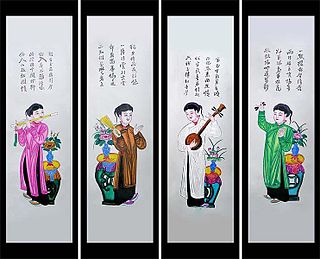
The history of Vietnam can be traced back to around 20,000 years ago. The first modern humans to arrive and settle in the area of modern-day Vietnam are known as the Hoabinhians, who can be traced as the ancestors of modern-day Negritos. Archaeological findings from 1965, which are still under research, show the remains of two hominins closely related to the Sinanthropus, dating as far back as the Middle Pleistocene era, roughly half a million years ago.
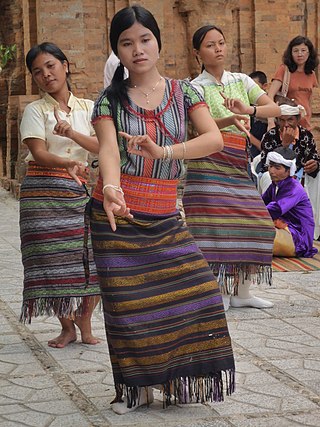
The Chams or Champa people are an Austronesian ethnic group in Southeast Asia, and indigenous people of Central Vietnam.
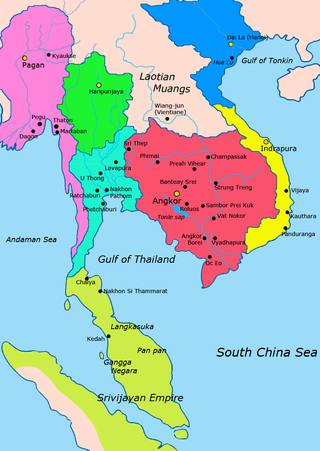
Champa was a collection of independent Cham polities that extended across the coast of what is present-day central and southern Vietnam from approximately the 2nd century AD until 1832. According to earliest historical references found in ancient sources, the first Cham polities were established around the 2nd to 3rd centuries CE, in the wake of Khu Liên's rebellion against the rule of China's Eastern Han dynasty, and lasted until when the final remaining principality of Champa was annexed by Emperor Minh Mạng of the Vietnamese Nguyễn dynasty as part of the expansionist Nam tiến policy. The kingdom was known variously as Nagaracampa, Champa (ꨌꩌꨛꨩ) in modern Cham, and Châmpa (ចាម្ប៉ា) in the Khmer inscriptions, Chiêm Thành in Vietnamese and Zhànchéng in Chinese records.

Islam is the religion of a majority of the Cham and Malay minorities in Cambodia. According to Po Dharma, there were 150,000 to 200,000 Muslims in Cambodia as late as 1975. Persecution under the Khmer Rouge eroded their numbers, however, and by the late 1980s they probably had not regained their former strength. In 2009, the Pew Research Center estimated that 1.6% of the population, or 236,000 people were Muslims. Like other Muslim Cham people, those in Cambodia are Sunni Muslims of the Shafi'i denomination and following the Maturidi doctrine. Po Dharma divides the Muslim Cham in Cambodia into a traditionalist branch and an orthodox branch.

The Cham script is a Brahmic abugida used to write Cham, an Austronesian language spoken by some 245,000 Chams in Vietnam and Cambodia. It is written horizontally left to right, just like other Brahmic abugidas.

The majority of Vietnamese do not follow any organized religion, instead participating in one or more practices of folk religions, such as venerating ancestors, or praying to deities, especially during Tết and other festivals. Folk religions were founded on endemic cultural beliefs that were historically affected by Confucianism and Taoism from ancient China, as well as by various strands of Buddhism. These three teachings or tam giáo were later joined by Christianity which has become a significant presence. Vietnam is also home of two indigenous religions: syncretic Caodaism and quasi-Buddhist Hoahaoism.

Cham is a Malayo-Polynesian language of the Austronesian family, spoken by the Chams of Southeast Asia. It is spoken primarily in the territory of the former Kingdom of Champa, which spanned modern Southern Vietnam, as well as in Cambodia by a significant population which descends from refugees that fled during the decline and fall of Champa. The Western variety is spoken by 220,000 people in Cambodia and 25,000 people in Vietnam. As for the Eastern variety, there are about 73,000 speakers in Vietnam, for a total of approximately 320,000 speakers.
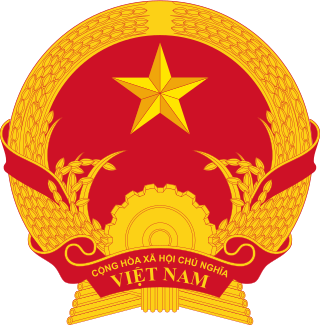
Human rights in Vietnam are among the poorest in the world, as considered by various domestic and international academics, dissidents and non-governmental organizations (NGOs) such as Amnesty International (AI), Human Rights Watch (HRW), and the United Nations High Commissioner for Human Rights (OHCHR).

Islam in Vietnam is primarily the religion of the Cham people, an Austronesian minority ethnic group; however, roughly one-third of Muslims in Vietnam are of other ethnic groups. There is also a community, which describes itself as of mixed ethnic origins, that practices Islam and is also known as the Cham, or Cham Muslims, around the region of Châu Đốc in the Southwest.

Phan Rang–Tháp Chàm, commonly known as Phan Rang, is a city in Vietnam and the capital of Ninh Thuận Province. The community has a population of 167,394 (2019), of which 95,000 (2019) live in the main city.
The Chamic languages, also known as Aceh–Chamic and Acehnese–Chamic, are a group of ten languages spoken in Aceh and in parts of Cambodia, Thailand, Vietnam and Hainan, China. The Chamic languages are a subgroup of Malayo-Polynesian languages in the Austronesian family. The ancestor of this subfamily, proto-Chamic, is associated with the Sa Huỳnh culture, its speakers arriving in what is now Vietnam from Formosa.
The Cham calendar is a lunisolar calendar used by the Cham people of Vietnam since ancient times. Its origins is based on Saka Raja calendar which was influenced by the Shaka era Indian Hindu calendar, with the current standard called Sakawi Cham likely instituted during the reign of Po Rome of the Champa kingdom.
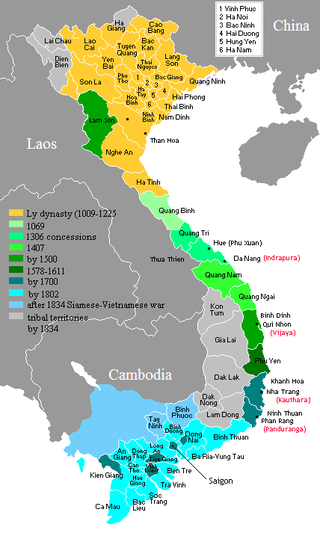
Nam tiến is a historiographical concept that describes the historic southward expansion of the territory of Vietnamese dynasties' dominions of Đại Việt from the 11th to the 19th centuries. The concept of Nam tiến has differing interpretations, with some equating it to Viet colonialism of the south and to a series of wars and conflicts between several Vietnamese kingdoms and Champa Kingdoms, which resulted in the annexation and Vietnamization of the former Cham states as well as indigenous territories.

Dalat station is a railway station on the Da Lat–Thap Cham Railway line in Vietnam, serving the town of Da Lat in Lâm Đồng Province. It was designed in 1932 by French architects Moncet and Reveron, and opened in 1938. Largely unused since abandonment of the railway during the later years of the Vietnam War, it was returned to a limited level of service in the 1990s with the reopening of a 7 km (4.3 mi) section of track leading to the nearby village of Trai Mat, operated as a tourist attraction. It is notable for its unique architectural style, which incorporates an overall Art Deco theme with elements of native Cao Nguyen communal houses from Vietnam's Central Highlands.
Racism in Vietnam has been mainly directed by the majority and dominant ethnic Vietnamese Kinh against ethnic minorities such as Degars (Montagnards), Chams and the Khmer Krom. It has also been directed against black people from other countries around the world as well.

Hinduism in Vietnam is mainly observed by the Balamon Cham people in Vietnam. Balamon Cham is one of two surviving non-Indic indigenous Hindu peoples. According to 2019 Vietnamese census, there are 64,547 Hindus live in Vietnam today.
Katip Sumat uprising was a revolt in 19th century Southern Vietnam. It was led by Cham Muslim leader Katip Sumat. This is the only ever-recorded jihad war involving Vietnam.

Turkey has an embassy in Hanoi and Vietnam has an embassy in Ankara, and a trade office in Istanbul.
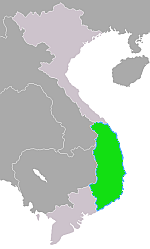
The Champa independence movement is a movement for the independence of the Cham people and its attempt to separate from Vietnam. Today's Cham separatism and their notion of nationhood is almost non-existent, according to international researchers.

Principality of Thuận Thành, commonly known to the Cham as Pänduranga or Prangdarang, neologism Panduranga Champa, was the last Cham state that centered around the modern day city of Phan Rang in Central Vietnam. Both Thuận Thành of Vietnamese perspectives and Panduranga were mutually used to refer to the last Cham polity. The decline and fading of Champa did not happen in a short period. Instead, for a long period from the late 17th century to 1832, Panduranga had been confined as an ad hoc client state of various Vietnamese dominions, but still maintained its faint independence. After a Cham revolt in 1692–94 and pressures from Cham king Po Saktiraydapatih, Southern Vietnamese lord Nguyễn Phúc Chu abolished his annexation of Panduranga and revived the Champa kingdom under the byname of Trấn Thuận Thành or the Principality of Thuận Thành, effectively made it a client state of the Nguyễn domain throughout the 18th century. Constant upheavals, social unrest, and the Tay Son rebellion in Dai Viet overthrew the ruling Nguyen and Trinh domains and Le dynasty during the late 18th century, and as long civil wars between Vietnamese factions raged, the principality of Thuận Thành continued to survive until summer 1832 when Vietnamese emperor Minh Mang annexed and incorporated the kingdom of Thuận Thành into his territory, decisively marking the final demise of the millennial Champa Kingdoms.